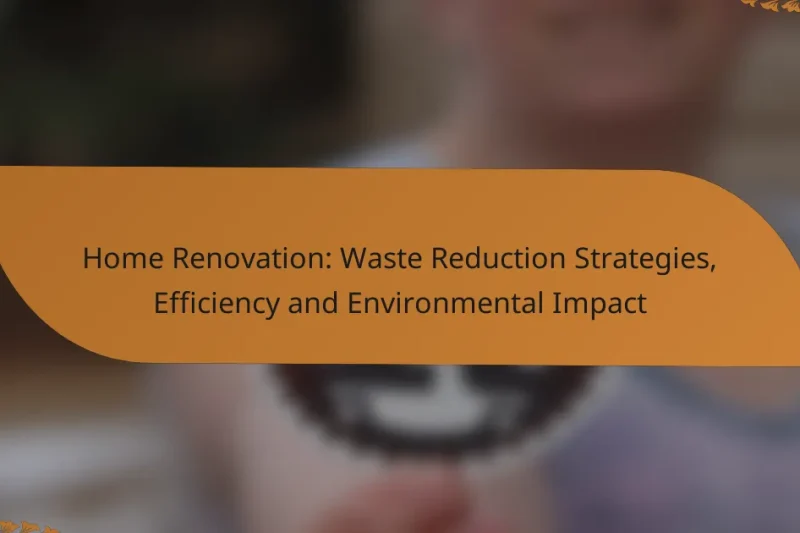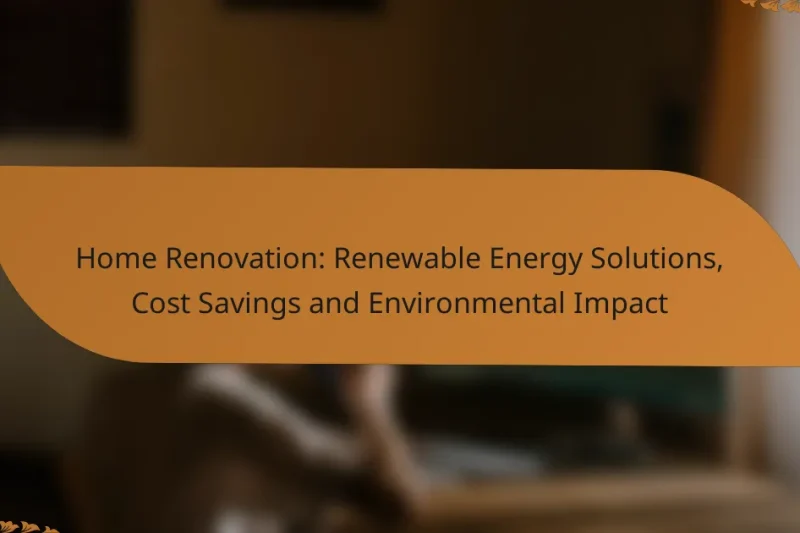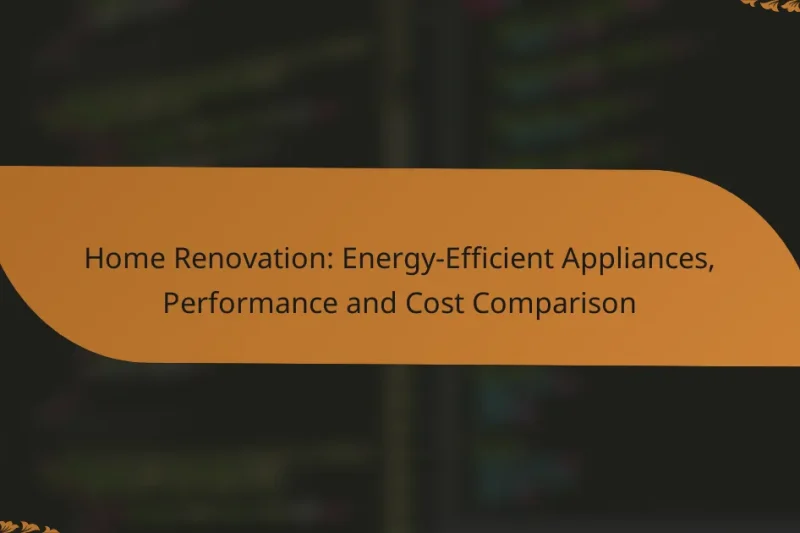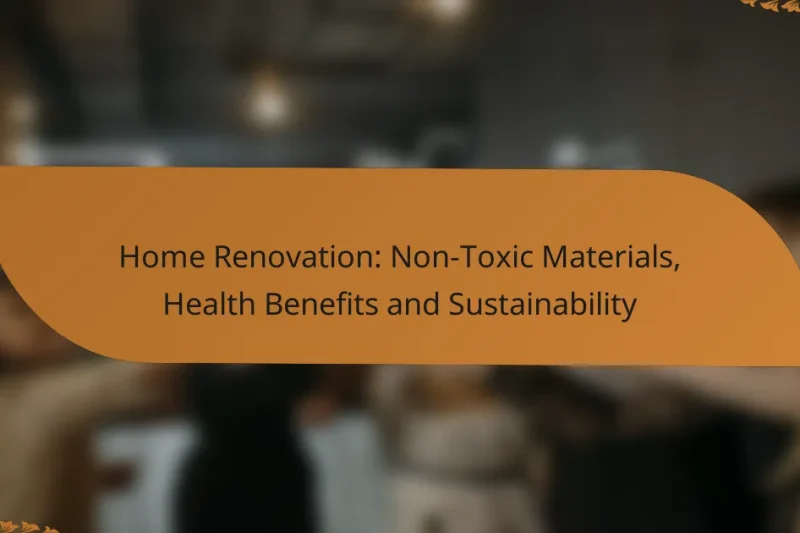Home renovation presents an opportunity to implement effective waste reduction strategies that minimize material waste and … Home Renovation: Waste Reduction Strategies, Efficiency and Environmental ImpactRead more
Sustainable Home Renovation
Sustainable home renovation emphasizes eco-friendly practices that reduce energy consumption, utilize renewable resources, and minimize waste. By selecting sustainable materials and implementing energy-efficient solutions, homeowners can create healthier living spaces while benefiting the environment and potentially saving on long-term costs.
Home Renovation: Renewable Energy Solutions, Cost Savings and Environmental Impact
Home renovation presents a unique opportunity to integrate renewable energy solutions that not only enhance energy … Home Renovation: Renewable Energy Solutions, Cost Savings and Environmental ImpactRead more
Home Renovation: Eco-Friendly Renovations, Long-Term Savings and Value
Home renovations that prioritize eco-friendliness not only contribute to a healthier planet but also offer significant … Home Renovation: Eco-Friendly Renovations, Long-Term Savings and ValueRead more
Home Renovation: Energy-Efficient Appliances, Performance and Cost Comparison
Incorporating energy-efficient appliances into your home renovation can lead to substantial savings and a reduced environmental … Home Renovation: Energy-Efficient Appliances, Performance and Cost ComparisonRead more
Home Renovation: Non-Toxic Materials, Health Benefits and Sustainability
Home renovation with non-toxic materials is essential for creating a healthier living environment while promoting sustainability. … Home Renovation: Non-Toxic Materials, Health Benefits and SustainabilityRead more
Home Renovation: Sustainable Landscaping Ideas, Aesthetics and Environmental Benefits
Sustainable landscaping ideas for home renovation focus on creating eco-friendly outdoor spaces that not only enhance … Home Renovation: Sustainable Landscaping Ideas, Aesthetics and Environmental BenefitsRead more
What are the best sustainable home renovation practices?
The best sustainable home renovation practices focus on reducing energy consumption, utilizing renewable resources, and minimizing waste. Implementing these practices not only benefits the environment but can also lead to long-term cost savings.
Energy-efficient insulation
Energy-efficient insulation is crucial for maintaining comfortable indoor temperatures while reducing heating and cooling costs. Consider materials such as cellulose, fiberglass, or spray foam, which have high R-values, indicating better thermal resistance.
When renovating, ensure that insulation is installed in walls, attics, and floors. Proper sealing of gaps and cracks can further enhance efficiency. Look for insulation products that meet local energy codes and have low environmental impact.
Solar panel installation
Installing solar panels is a powerful way to harness renewable energy and reduce reliance on fossil fuels. Solar systems can significantly lower electricity bills and may even allow homeowners to sell excess energy back to the grid.
Before installation, assess your roof’s orientation and shading to determine the potential energy output. Research local incentives and rebates, as many regions offer financial support for solar installations, making them more affordable.
Water-saving fixtures
Water-saving fixtures, such as low-flow faucets, showerheads, and dual-flush toilets, can drastically reduce water consumption in a home. These fixtures are designed to maintain performance while using significantly less water.
When selecting water-saving options, look for products with the WaterSense label, which indicates they meet efficiency criteria set by the Environmental Protection Agency. This can lead to lower water bills and a reduced environmental footprint.
Recycled materials usage
Using recycled materials in home renovations helps divert waste from landfills and reduces the demand for new resources. Options include reclaimed wood, recycled metal, and repurposed bricks, which can add character and sustainability to your project.
When sourcing recycled materials, check local suppliers or salvage yards. Ensure that the materials meet safety and quality standards. Incorporating these materials can enhance the aesthetic appeal while supporting eco-friendly practices.
How to choose sustainable materials for renovations?
Choosing sustainable materials for renovations involves selecting products that minimize environmental impact while ensuring durability and safety. Focus on materials that are certified, low in harmful chemicals, or sourced from reclaimed resources to create a healthier living space.
Certified sustainable wood
Certified sustainable wood comes from forests that are managed according to strict environmental and social standards. Look for certifications such as FSC (Forest Stewardship Council) or PEFC (Programme for the Endorsement of Forest Certification) to ensure the wood is harvested responsibly.
When selecting wood, consider its application—hardwoods are often more durable for flooring, while softwoods may be suitable for framing. Be aware that certified wood can sometimes be more expensive, but the long-term benefits often outweigh the initial costs.
Low-VOC paints
Low-VOC (volatile organic compounds) paints are formulated to reduce harmful emissions, making them a safer choice for indoor air quality. These paints contain fewer toxic chemicals, which can contribute to respiratory issues and other health problems.
When choosing low-VOC paints, check labels for VOC content, aiming for products with less than 50 grams per liter. Brands often offer a range of colors and finishes, allowing you to maintain aesthetic appeal without compromising health.
Reclaimed materials
Reclaimed materials are salvaged from old buildings or structures, providing a sustainable option that reduces waste and the demand for new resources. Common reclaimed materials include wood beams, bricks, and fixtures, which can add unique character to your renovation.
When sourcing reclaimed materials, ensure they are in good condition and free from harmful substances like lead paint or asbestos. Local salvage yards or online marketplaces can be excellent resources for finding quality reclaimed items at reasonable prices.
What are the costs associated with sustainable home renovations?
The costs of sustainable home renovations can vary widely based on the scope of the project, materials used, and labor. Generally, homeowners can expect to invest more upfront compared to traditional renovations, but these costs may be offset by long-term savings on energy bills and potential tax incentives.
Average cost of energy-efficient upgrades
Energy-efficient upgrades typically range from a few hundred to several thousand dollars, depending on the type of improvement. For instance, installing energy-efficient windows can cost between $300 to $1,000 per window, while upgrading insulation may range from $1,000 to $3,000 for an average home.
Homeowners should consider the potential return on investment (ROI) when evaluating these costs. Energy-efficient upgrades can lead to savings of 10-30% on energy bills, making them financially beneficial over time.
Cost comparison of sustainable vs. traditional materials
Sustainable materials often come with a higher initial price tag compared to traditional options. For example, reclaimed wood may cost 10-20% more than new lumber, while bamboo flooring can be comparable in price to hardwood but offers a more sustainable choice.
However, the longevity and durability of sustainable materials can lead to lower maintenance costs in the long run. It’s essential to weigh the upfront costs against the long-term benefits, such as reduced environmental impact and potential energy savings.
How to find local contractors for sustainable renovations?
To find local contractors for sustainable renovations, start by researching professionals who specialize in eco-friendly practices and materials. Look for certifications and reviews to ensure they meet sustainability standards and have a good reputation in your area.
Green-certified contractors in Los Angeles
In Los Angeles, green-certified contractors are essential for ensuring that your renovation meets environmental standards. Look for contractors who are certified by organizations like the U.S. Green Building Council or the National Association of Home Builders. These certifications indicate that the contractor is knowledgeable about sustainable practices.
When selecting a contractor, ask for examples of past projects that demonstrate their commitment to sustainability. Many green-certified contractors use energy-efficient materials and techniques, which can lead to long-term savings on utility bills.
Online platforms for eco-friendly renovation services
Several online platforms can connect you with eco-friendly renovation services. Websites like HomeAdvisor, Thumbtack, and Houzz allow you to filter contractors based on their sustainability practices and customer reviews. This can save time and help you find qualified professionals quickly.
Additionally, consider using local directories that focus on green businesses. These platforms often provide detailed information about the contractors’ eco-friendly practices, making it easier to compare options and make an informed decision.
What are the benefits of sustainable home renovations?
Sustainable home renovations offer numerous advantages, including cost savings, increased property value, and a healthier living environment. By utilizing eco-friendly materials and energy-efficient systems, homeowners can create spaces that are both functional and environmentally responsible.
Long-term cost savings
One of the primary benefits of sustainable renovations is long-term cost savings. Energy-efficient upgrades, such as better insulation and high-efficiency appliances, can significantly reduce utility bills over time. Homeowners may save anywhere from 20% to 50% on energy costs, depending on the improvements made.
Additionally, investing in sustainable materials can lead to lower maintenance costs. For example, durable materials like bamboo flooring or recycled metal roofing often require less upkeep compared to traditional options, further enhancing savings.
Increased property value
Sustainable home renovations can lead to increased property value, appealing to a growing market of environmentally conscious buyers. Homes with energy-efficient features often sell for a premium, with some studies indicating that such homes can fetch up to 10% more than similar properties without these upgrades.
Moreover, as energy efficiency becomes a priority for many buyers, having a home that meets green building standards can make it more competitive in the real estate market. Features like solar panels or energy-efficient windows can be strong selling points.
Healthier living environment
Renovating sustainably can create a healthier living environment by reducing exposure to harmful chemicals and improving indoor air quality. Using low-VOC (volatile organic compounds) paints and finishes can minimize toxins in the home, benefiting the health of its occupants.
Moreover, energy-efficient systems often include better ventilation, which can help reduce moisture and mold growth. This is particularly important in areas prone to humidity, as it contributes to a more comfortable and safer living space.
What are the prerequisites for a sustainable renovation project?
To ensure a sustainable renovation project, it is essential to assess energy efficiency, comply with local regulations, and consider environmentally friendly materials. These prerequisites help minimize environmental impact while maximizing energy savings and comfort.
Energy audit requirements
An energy audit is a critical first step in identifying areas for improvement in a home’s energy efficiency. This process typically involves a professional evaluation of insulation, heating and cooling systems, and overall energy consumption patterns.
Homeowners should expect to receive a detailed report outlining specific recommendations, which may include upgrading insulation, sealing leaks, or replacing inefficient appliances. Many utility companies offer incentives or rebates for completing energy audits, making this step both beneficial and cost-effective.
Local building codes and regulations
Understanding local building codes and regulations is vital for any renovation project. These codes dictate the standards for construction, safety, and energy efficiency, ensuring that renovations meet community and environmental standards.
Before starting any work, check with local authorities to obtain necessary permits and ensure compliance with regulations. This may include adhering to energy efficiency standards such as the International Energy Conservation Code (IECC) or local equivalents, which can vary significantly by region.





